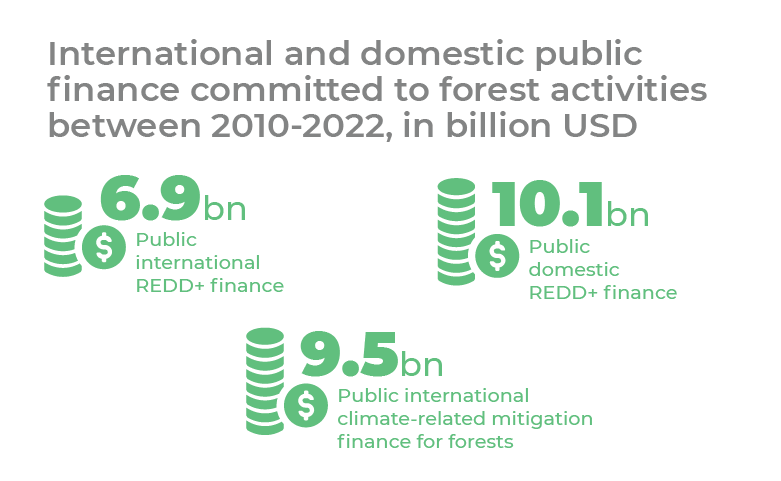Achieving international forest goals requires substantial investment in protecting and restoring forests. Under the Paris Agreement, parties committed to making finance flows consistent with a pathway towards low greenhouse gas emissions and climate-resilient development (Art.2.1.c). The Forest Declaration Assessment Partners estimate that it will cost up to USD 460 billion per year to reduce deforestation and implement restoration and sustainable forest management at a sufficient scale to protect and restore forests globally. This funding must be mobilized through both public and private sources - this report assesses the extent to which global public and private finance is currently aligned with forest goals.
Stopping deforestation not only requires more finance earmarked for forest protection and restoration (referred to as “green” finance in this report), but also a shift away from investments in potentially harmful activities (referred to as “gray” finance). Estimates suggest that every year, between USD 378 to USD 635 billion in public gray finance is being provided by governments in the form of agricultural subsidies - activities that are potentially harmful to forests.
Findings
Finance for forests remains far off track to meeting global goals to halt and reverse deforestation by 2030. Currently, domestic and international mitigation and adaptation finance for forests averages USD 2.2 billion per year – less than 1 percent of estimated needs for meeting global forest goals by 2050.
Recent international forest finance pledges demonstrate increases in ambition to meet 2030 forest goals. Commitments amount to USD 28.9 billion between the years 2021-25, equating to an additional USD 4 billion in public and private finance for forests per year. However, a lack of information on how pledges will be operationalized and poor transparency on implementation hinders a full assessment of progress. As of October 2023, just over USD 5.7 billion has been disbursed. Half of the pledges are reported to be on track, but the remainder are not on track or have no progress reports available.
Public finance committed to activities that have the potential to drive deforestation or forest degradation (“gray” finance) continues to far outweigh finance committed to forest protection (“green” finance). Between 2013-2018, grey public finance flows were estimated to range between USD 378 to USD 635 billion per year, globally. During the same period, governments committed just USD 26.5 billion in domestic and international funding to protect, conserve, and restore forests (see Figure). These green finance flows amount to just USD 2.2 billion per year – less than 1 percent of grey flows.
| Figure: International and domestic public finance committed to activities aligned with global forest objectives between 2010-2022, in billion USD |

How do we assess progress?
This chapter assesses the extent to which global public and private finance is aligned with forest goals. We assess the following indicators of progress:
The forest ecosystems that support a liveable climate, invaluable biodiversity, thriving economies, and intangible cultural importance remain under massive pressure. Standing forests are essential for limiting global warming to 1.5°C. Yet, the world remains off track to reach the 2030 goals of halting and reversing deforestation and forest degradation by 2030.
Through a comprehensive analysis across four main chapters-- Overarching forest goals (Theme 1), Sustainable production and development (Theme 2), Finance for forests (Theme 3), and Forest governance (Theme 4), along with 7 country case studies and a set of Recommendations—the 2023 Forest Declaration Assessment sheds light on the state of global forest action.


